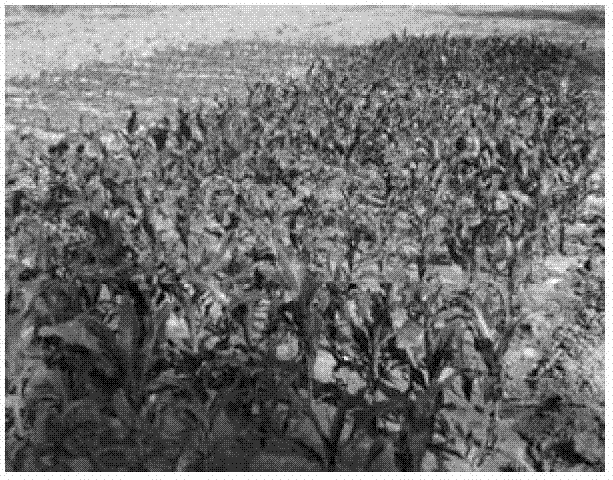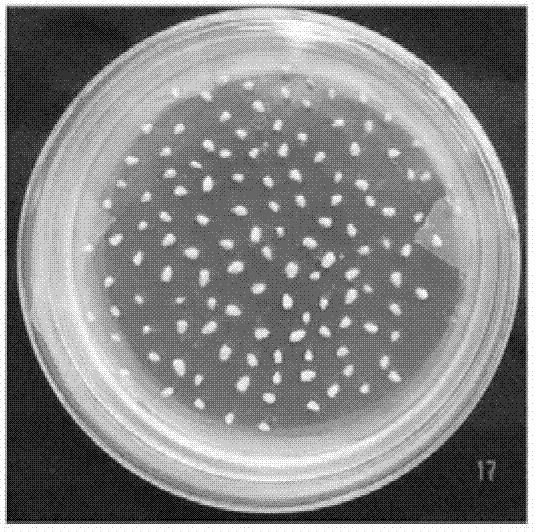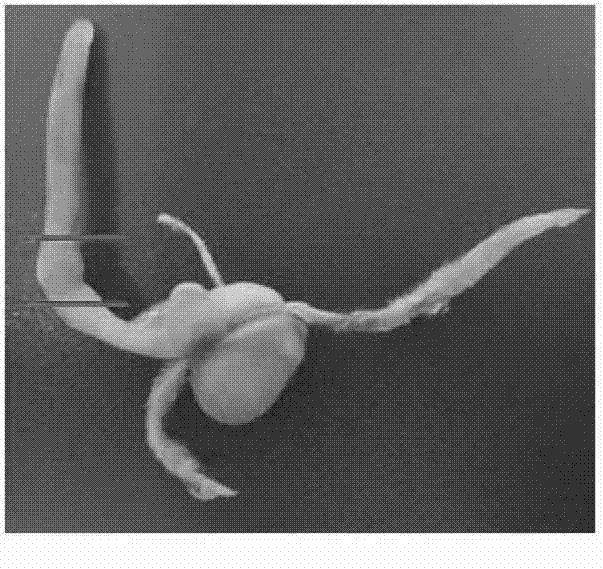Anniversary large-scale maize transformation method
A large-scale, corn technology, applied in horticultural methods, botanical equipment and methods, introduction of foreign genetic material using vectors, etc., can solve the problems of hindering the development of transgenic corn, unable to screen out a single plant, low transformation rate, etc. Large-scale transformation, easy plant regeneration, and high regeneration efficiency
- Summary
- Abstract
- Description
- Claims
- Application Information
AI Technical Summary
Problems solved by technology
Method used
Image
Examples
Embodiment 1
[0056] Example 1 Large-scale transformation of young maize embryos mediated by Agrobacterium tumefaciens
[0057] 1. Planting of batch material in the field
[0058] The corn receptor material is sown in batches during the corn growing season, usually every 4-7 days. When the temperature is low in early spring, methods such as raising seedlings, laying plastic film, and erecting small sheds can be used to promote the growth of corn.
[0059] Strictly bagging, self-crossing or sister-crossing before corn loosening, control the number of pollinated plants to roughly the same number every day.
[0060] Pollination is 9-13 days, when the young embryo grows to 1.5-2.0mm, take the ear and peel the embryo, and shorten the time between getting the ear and peeling the embryo as much as possible.
[0061] 2. Preparation of Agrobacterium tumefaciens (containing the gene of interest)
[0062] (1) Preparation of Competent Agrobacterium: Pick a single colony of Agrobacterium tumefaciens ...
Embodiment 2
[0080] Example 2 Large-scale transformation of maize coleoptile node callus mediated by Agrobacterium tumefaciens
[0081] 1. Seed sterilization
[0082] First, clean up the sundries in the corn seeds, select the full and complete seeds, and then put them in a container and wash them with distilled water 3 times, during which time they shake vigorously to clean up the residues on the attached surface. Soak it in 75% alcohol for 3 minutes on the ultra-clean table, then soak it in 5.25% sodium hypochlorite for 20 minutes, and finally rinse it with sterilized water for 5-6 times.
[0083] 2. Germination culture
[0084] Place the sterilized seeds in the germination medium, and pay attention to horizontally inoculate the embryos of the seeds in the germination medium. In the culture room (16h / d light, light intensity 80-100μE / m 2 / s, 26-28℃) for 7-10 days.
[0085] The above germination medium is the following substances and final concentrations added to the MS basic medium: m...
Embodiment 3
[0120] Example 3 PCR detection of transgenic corn
[0121] 1. Extraction of DNA from maize leaves (CTAB method)
[0122] Cut the 2-3cm long transgenic corn plant leaves and cut them into pieces, put them into a 2.0ml centrifuge tube, add a steel ball; place the centrifuge tubes with the leaves and steel balls in the centrifuge tube rack dedicated to the sampler in order (8×5), soak the whole in a fresh-keeping box filled with liquid nitrogen for 1-2min; put the frozen centrifuge tube rack into the sampler, and sample at 1200 rpm for 20s; add 600μL CTAB extract ( 65°C preheating), 65°C water bath for 30min, take out and invert 1-2 times in the middle; add an equal volume (600uL) of chloroform:isoamyl alcohol (24:1) extract, close the lid tightly, mix up and down, and let stand 10-15min. Centrifuge at 11,000 rpm for 5 minutes until the phases are clearly separated; absorb 500 μL of the supernatant, transfer it to a new 1.5 mL sterilized centrifuge tube, add 2 / 3 volume of isopr...
PUM
 Login to View More
Login to View More Abstract
Description
Claims
Application Information
 Login to View More
Login to View More - R&D
- Intellectual Property
- Life Sciences
- Materials
- Tech Scout
- Unparalleled Data Quality
- Higher Quality Content
- 60% Fewer Hallucinations
Browse by: Latest US Patents, China's latest patents, Technical Efficacy Thesaurus, Application Domain, Technology Topic, Popular Technical Reports.
© 2025 PatSnap. All rights reserved.Legal|Privacy policy|Modern Slavery Act Transparency Statement|Sitemap|About US| Contact US: help@patsnap.com



